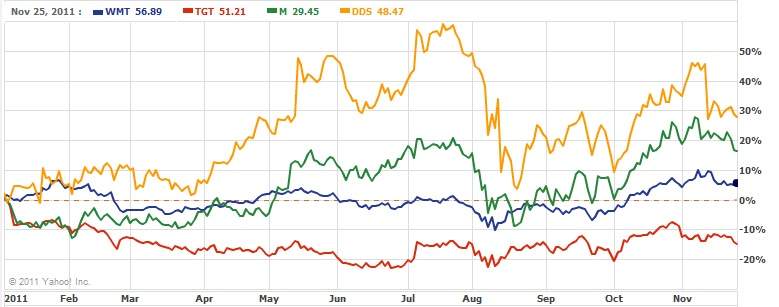This time of year investors tend to turn their attention to the retail sector as we enter the critical holiday shopping period. Analysts focus on Black Friday and its younger sibling, Cyber Monday, to determine which retail companies are likely to experience strong holiday sales. With so much attention being paid to the income gap in this country, I decided to look at the high-end retailers versus the discount retailers.
Is Macy's (NYSE: M) a better investment than Wal-Mart (NYSE: WMT)? What about Target (NYSE: TGT) compared to high-end department store Dillard's (NYSE: DDS)? These four retailers epitomize the high-end and the low-end and by looking at the fundamentals of the four, they all look pretty similar.
The following table shows the P/E ratio, the quarterly revenue growth year over year and the historical long-term growth of all four. As you can see, all four P/E ratios are in a tight range between 10.8 and 12.3. The revenue growth is pretty tightly packed as well with the rates ranging from 3.2 percent at Dillard's to 8.1 percent for Wal-Mart. Macy's has the highest long-term growth rate at 12.45 percent with Dillard's lagging the other three slightly.

Most of these numbers show a pretty tight range for the past results. However, if we look at the growth estimates for the current quarter and the next quarter, this is where we see big discrepancies.

The high-end companies (Macy's and Dillard's) are both expected to show growth of over 20 percent in the next quarter and Dillard's is expected to see growth of 32.9 percent during the current quarter. Meanwhile, the low-end stores of Target and Wal-Mart are expected to see growth in the eight percent range this quarter and Target is actually expected to see sales contract in the next quarter.
Outperformance on the Charts
It is said that the stock market is a forward looking machine. Given the current growth estimates for Dillard's and Macy's versus Target and Wal-Mart, the market performance in 2011 has clearly reflected the performance of these companies.
Looking at the chart below, we see that both DDS and M have outperformed WMT and TGT throughout the course of 2011. We see that Dillard's has outpaced the other three stocks with a gain of 28.64 percent through November 25 (Black Friday). Macy's has performed well also with a gain of 17.38 percent.
Meanwhile, Wal-Mart has been grinding sideways for most of the year. It hasn't been up more than 10 percent and it hasn't been down more than 10 percent since the first of the year. Target has not fared as well as any of the other three and has experienced a loss of 14.64 percent so far in 2011.

Whether it is a function of the income gap or not, high-end retail stocks have performed much better than the discount names. This outperformance hasn't just been over the course of this year either. Dillard's and Macy's have outperformed Wal-Mart and Target for the past three years, at least the stocks have.
Since the recession in 2007, unemployment has been much higher than historical levels. Many of the jobs that were lost were in the construction sector as the housing boom went bust. These were not the typical Macy's and Dillard's shoppers, but were more likely to shop at Wal-Mart or Target.
I look for this trend to continue through the next year as well. Based on the current performance of the stocks along with the projected growth for the companies, the high-end retail names appear on pace to outperform the discount names going forward. Stores like Macy's and Dillard's don't discount their merchandise nearly as much as Target and Wal-Mart and as a result they are likely to outperform on the bottom line.
The current economy shows no progress being made on the employment front that suggests the unemployment rate is going to be coming down anytime soon. And as long as the employment picture continues on the slow recovery, Wal-Mart and Target are likely to struggle with their growth.
![]()
 Facebook
Facebook
 Twitter
Twitter